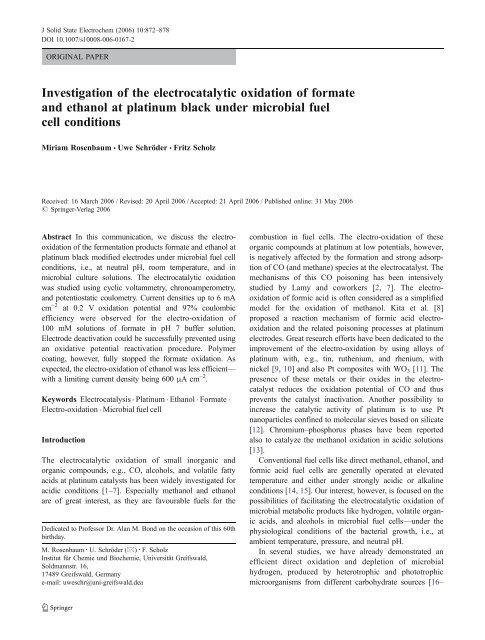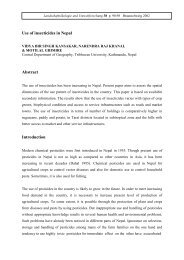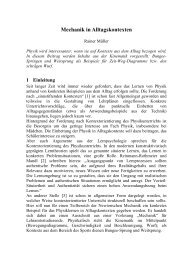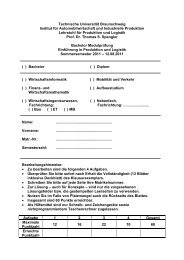Investigation of the electrocatalytic oxidation of formate and ethanol ...
Investigation of the electrocatalytic oxidation of formate and ethanol ...
Investigation of the electrocatalytic oxidation of formate and ethanol ...
You also want an ePaper? Increase the reach of your titles
YUMPU automatically turns print PDFs into web optimized ePapers that Google loves.
J Solid State Electrochem (2006) 10:872–878<br />
DOI 10.1007/s10008-006-0167-2<br />
ORIGINAL PAPER<br />
<strong>Investigation</strong> <strong>of</strong> <strong>the</strong> <strong>electrocatalytic</strong> <strong>oxidation</strong> <strong>of</strong> <strong>formate</strong><br />
<strong>and</strong> <strong>ethanol</strong> at platinum black under microbial fuel<br />
cell conditions<br />
Miriam Rosenbaum & Uwe Schröder & Fritz Scholz<br />
Received: 16 March 2006 / Revised: 20 April 2006 /Accepted: 21 April 2006 / Published online: 31 May 2006<br />
# Springer-Verlag 2006<br />
Abstract In this communication, we discuss <strong>the</strong> electro<strong>oxidation</strong><br />
<strong>of</strong> <strong>the</strong> fermentation products <strong>formate</strong> <strong>and</strong> <strong>ethanol</strong> at<br />
platinum black modified electrodes under microbial fuel cell<br />
conditions, i.e., at neutral pH, room temperature, <strong>and</strong> in<br />
microbial culture solutions. The <strong>electrocatalytic</strong> <strong>oxidation</strong><br />
was studied using cyclic voltammetry, chronoamperometry,<br />
<strong>and</strong> potentiostatic coulometry. Current densities up to 6 mA<br />
cm −2 at 0.2 V <strong>oxidation</strong> potential <strong>and</strong> 97% coulombic<br />
efficiency were observed for <strong>the</strong> electro-<strong>oxidation</strong> <strong>of</strong><br />
100 mM solutions <strong>of</strong> <strong>formate</strong> in pH 7 buffer solution.<br />
Electrode deactivation could be successfully prevented using<br />
an oxidative potential reactivation procedure. Polymer<br />
coating, however, fully stopped <strong>the</strong> <strong>formate</strong> <strong>oxidation</strong>. As<br />
expected, <strong>the</strong> electro-<strong>oxidation</strong> <strong>of</strong> <strong>ethanol</strong> was less efficient—<br />
with a limiting current density being 600 μA cm −2 .<br />
Keywords Electrocatalysis . Platinum . Ethanol . Formate .<br />
Electro-<strong>oxidation</strong> . Microbial fuel cell<br />
Introduction<br />
The <strong>electrocatalytic</strong> <strong>oxidation</strong> <strong>of</strong> small inorganic <strong>and</strong><br />
organic compounds, e.g., CO, alcohols, <strong>and</strong> volatile fatty<br />
acids at platinum catalysts has been widely investigated for<br />
acidic conditions [1–7]. Especially m<strong>ethanol</strong> <strong>and</strong> <strong>ethanol</strong><br />
are <strong>of</strong> great interest, as <strong>the</strong>y are favourable fuels for <strong>the</strong><br />
Dedicated to Pr<strong>of</strong>essor Dr. Alan M. Bond on <strong>the</strong> occasion <strong>of</strong> this 60th<br />
birthday.<br />
M. Rosenbaum : U. Schröder (*) : F. Scholz<br />
Institut für Chemie und Biochemie, Universität Greifswald,<br />
Soldmannstr. 16,<br />
17489 Greifswald, Germany<br />
e-mail: uweschr@uni-greifswald.dea<br />
combustion in fuel cells. The electro-<strong>oxidation</strong> <strong>of</strong> <strong>the</strong>se<br />
organic compounds at platinum at low potentials, however,<br />
is negatively affected by <strong>the</strong> formation <strong>and</strong> strong adsorption<br />
<strong>of</strong> CO (<strong>and</strong> methane) species at <strong>the</strong> electrocatalyst. The<br />
mechanisms <strong>of</strong> this CO poisoning has been intensively<br />
studied by Lamy <strong>and</strong> coworkers [2, 7]. The electro<strong>oxidation</strong><br />
<strong>of</strong> formic acid is <strong>of</strong>ten considered as a simplified<br />
model for <strong>the</strong> <strong>oxidation</strong> <strong>of</strong> m<strong>ethanol</strong>. Kita et al. [8]<br />
proposed a reaction mechanism <strong>of</strong> formic acid electro<strong>oxidation</strong><br />
<strong>and</strong> <strong>the</strong> related poisoning processes at platinum<br />
electrodes. Great research efforts have been dedicated to <strong>the</strong><br />
improvement <strong>of</strong> <strong>the</strong> electro-<strong>oxidation</strong> by using alloys <strong>of</strong><br />
platinum with, e.g., tin, ru<strong>the</strong>nium, <strong>and</strong> rhenium, with<br />
nickel [9, 10] <strong>and</strong> also Pt composites with WO 3 [11]. The<br />
presence <strong>of</strong> <strong>the</strong>se metals or <strong>the</strong>ir oxides in <strong>the</strong> electrocatalyst<br />
reduces <strong>the</strong> <strong>oxidation</strong> potential <strong>of</strong> CO <strong>and</strong> thus<br />
prevents <strong>the</strong> catalyst inactivation. Ano<strong>the</strong>r possibility to<br />
increase <strong>the</strong> catalytic activity <strong>of</strong> platinum is to use Pt<br />
nanoparticles confined to molecular sieves based on silicate<br />
[12]. Chromium–phosphorus phases have been reported<br />
also to catalyze <strong>the</strong> m<strong>ethanol</strong> <strong>oxidation</strong> in acidic solutions<br />
[13].<br />
Conventional fuel cells like direct m<strong>ethanol</strong>, <strong>ethanol</strong>, <strong>and</strong><br />
formic acid fuel cells are generally operated at elevated<br />
temperature <strong>and</strong> ei<strong>the</strong>r under strongly acidic or alkaline<br />
conditions [14, 15]. Our interest, however, is focused on <strong>the</strong><br />
possibilities <strong>of</strong> facilitating <strong>the</strong> <strong>electrocatalytic</strong> <strong>oxidation</strong> <strong>of</strong><br />
microbial metabolic products like hydrogen, volatile organic<br />
acids, <strong>and</strong> alcohols in microbial fuel cells—under <strong>the</strong><br />
physiological conditions <strong>of</strong> <strong>the</strong> bacterial growth, i.e., at<br />
ambient temperature, pressure, <strong>and</strong> neutral pH.<br />
In several studies, we have already demonstrated an<br />
efficient direct <strong>oxidation</strong> <strong>and</strong> depletion <strong>of</strong> microbial<br />
hydrogen, produced by heterotrophic <strong>and</strong> phototrophic<br />
microorganisms from different carbohydrate sources [16–
J Solid State Electrochem (2006) 10:872–878 873<br />
Current / mA<br />
Current / mA<br />
80<br />
70<br />
60<br />
50<br />
40<br />
30<br />
20<br />
10<br />
0<br />
12<br />
10<br />
8<br />
6<br />
4<br />
2<br />
0<br />
a<br />
-0.2 0.0 0.2 0.4 0.6 0.8<br />
b<br />
-0.2 0.0 0.2 0.4 0.6 0.8<br />
Potential / V<br />
Fig. 1 Cyclic voltammograms <strong>of</strong> <strong>the</strong> <strong>electrocatalytic</strong> <strong>oxidation</strong> <strong>of</strong> a<br />
<strong>formate</strong> <strong>and</strong> b <strong>ethanol</strong> at platinum black modified platinum paddle<br />
electrodes (5 cm 2 projected surface area), measured in pH 7 phosphate<br />
buffer solution. The scan rate was 10 mV s −1 . The voltammograms<br />
were recorded before <strong>and</strong> after <strong>the</strong> exhaustive electrochemical<br />
<strong>oxidation</strong>, shown in Fig. 2. a-A: 91 mM sodium <strong>formate</strong>; b-B<br />
14.6 mM <strong>formate</strong> (after 22 h <strong>of</strong> electrochemical <strong>oxidation</strong> at 0.2 V,<br />
experiment Fig. 2); a-C: After re-addition <strong>of</strong> sodium <strong>formate</strong> to a final<br />
concentration <strong>of</strong> 75 mM. b-A: 98 mM <strong>ethanol</strong>; b-B: 89 mM <strong>ethanol</strong><br />
(after 17 h <strong>of</strong> electrochemical <strong>oxidation</strong> at 0.2 V, experiment Fig. 2)<br />
19]. For that we have developed a novel s<strong>and</strong>wiched anode<br />
material [17, 19, 20] consisting <strong>of</strong> a noble metal electrocatalyst<br />
<strong>and</strong> a polymer overlay that prevents <strong>the</strong> electrocatalyst<br />
from poisoning. To increase <strong>the</strong> versatility <strong>and</strong><br />
efficiency <strong>of</strong> such microbial fuel cell system, it is necessary<br />
to access as many electron-rich fermentation products as<br />
possible for direct <strong>oxidation</strong> <strong>and</strong> electricity generation. In<br />
this communication, we present <strong>the</strong> results <strong>of</strong> a study on <strong>the</strong><br />
<strong>electrocatalytic</strong> <strong>oxidation</strong> <strong>of</strong> <strong>formate</strong> <strong>and</strong> <strong>ethanol</strong>, major<br />
products <strong>of</strong> different microbial fermentation pathways, at<br />
platinum black electrodes <strong>and</strong> polyaniline-modified-platinum<br />
electrodes under microbial fuel cell conditions.<br />
Experiments were performed in syn<strong>the</strong>tic buffer solution<br />
<strong>and</strong> in anaerobic solutions <strong>of</strong> living cells Escherichia coli<br />
K12.<br />
B<br />
A<br />
A<br />
C<br />
B<br />
16<br />
14<br />
12<br />
10<br />
8<br />
6<br />
4<br />
2<br />
0<br />
2.4<br />
2.0<br />
1.6<br />
1.2<br />
0.8<br />
0.4<br />
0.0<br />
Current density / mA cm -2<br />
Current density / mA cm -2<br />
Materials <strong>and</strong> methods<br />
Electrochemical instrumentation<br />
All experiments were carried out using a conventional<br />
three-electrode arrangement. Silver–silver chloride electrodes,<br />
sat. KCl, 0.195 V vs SHE, served as reference<br />
electrodes. The counter electrodes were graphite rods. They<br />
were separated from <strong>the</strong> electrolyte solution by a Nafion<br />
117 perflourinated membrane. The working electrodes,<br />
platinum paddle electrodes (geometrical active surface area<br />
5cm 2 ), were electrochemically platinized for 500 s at a<br />
potential <strong>of</strong> −0.6 V in a stirred acidic solution containing<br />
12 mM H 2 PtCl 6 (Fluka). For comparative studies, some<br />
electrodes were subsequently coated with polyaniline [19].<br />
The polymerization <strong>of</strong> aniline followed a st<strong>and</strong>ard literature<br />
procedure, i.e., it was achieved by potential cycling<br />
between −0.1 <strong>and</strong> 1.2 V from an aqueous solution<br />
containing 0.1 mol l −1 H 2 SO 4 <strong>and</strong> 0.1 mol l −1 aniline (scan<br />
rate 0.1 V s −1 , 15 cycles) [21]. All current density values in<br />
this communication refer to <strong>the</strong> geometrical electrode<br />
surface area.<br />
All experiments were conducted using Autolab potentiostats<br />
(PSTAT10, PGSTAT20 <strong>and</strong> 30, Ecochemie, Ne<strong>the</strong>rl<strong>and</strong>s).<br />
The PGSTAT 30 was equipped with five array<br />
modules allowing multi-working electrode measurements.<br />
Chronoamperometric measurements <strong>and</strong> potentiostatic coulometry<br />
were performed at 0.2 V, a potential typical for low<br />
external load conditions in microbial fuel cells [19].<br />
Electrode inactivation, caused by <strong>the</strong> incomplete <strong>oxidation</strong><br />
<strong>of</strong> <strong>the</strong> target substrates <strong>and</strong> o<strong>the</strong>r oxidizable compounds in<br />
<strong>the</strong> bacterial medium [19], was prevented by using in situ<br />
regenerative potential pulsing as it was presented in<br />
previous papers [19, 20]. For that, in intervals <strong>of</strong> 1,000 s,<br />
a potential <strong>of</strong> 1 V was applied for 5 s to <strong>the</strong> working<br />
electrode to oxidatively strip <strong>of</strong>f chemisorbed species from<br />
<strong>the</strong> electrode surface. The pulse was followed by 5 s<br />
equilibration (open circuit).<br />
Except for <strong>the</strong> experiments that were performed using<br />
anaerobic living cultures <strong>of</strong> E. coli, all electrochemical<br />
experiments were carried out in pH 7 phosphate buffer<br />
solutions (50 mM KH 2 PO 4 ;50mMK 2 HPO 4 ).<br />
Substrate conversion analysis<br />
Substrate exhaustion <strong>and</strong> product formation were followed<br />
by HPLC analysis. The HPLC (Knaur, Germany) was<br />
equipped with a Rezex ROA-Organic Acid column in<br />
combination with <strong>the</strong> SecurityGuard cartridge AJO-4490.<br />
The chromatograms were recorded at a column temperature<br />
<strong>of</strong> 55 °C with 0.005 n sulfuric acid as <strong>the</strong> eluent; <strong>the</strong><br />
detector was a differential refractometer.
874 J Solid State Electrochem (2006) 10:872–878<br />
Current / mA<br />
45<br />
40<br />
35<br />
30<br />
25<br />
20<br />
15<br />
10<br />
5<br />
0<br />
10<br />
9<br />
8<br />
7<br />
6<br />
5<br />
4<br />
3<br />
2<br />
1<br />
0 6 12 18<br />
Time / h<br />
Fig. 2 Chronoamperograms recorded at platinum black electrodes<br />
(5 cm 2 geometrical surface area) immersed in 100 ml, pH 7 phosphate<br />
buffer solutions (stirred). a The solution contained 91 mM <strong>formate</strong><br />
(initial concentration); curve (A): constant potential, without electrode<br />
regeneration protocol; curve (B): application <strong>of</strong> <strong>the</strong> oxidative<br />
regeneration procedure; b The electrolyte solution contained 98 mM<br />
<strong>ethanol</strong> (initial concentration). The experiment was performed using<br />
<strong>the</strong> regenerative potential pulsing<br />
Bacterial growth<br />
A<br />
B<br />
Escherichia coli K12 was kindly provided by <strong>the</strong> Division<br />
<strong>of</strong> Applied Microbiology, Institute <strong>of</strong> Microbiology <strong>and</strong><br />
Molecular Biology, University <strong>of</strong> Greifswald. The aerobic<br />
cultivation <strong>and</strong> anaerobic electrochemical experiments were<br />
j / mA cm -2<br />
0 500 1000 1500 2000<br />
t / s<br />
0 6 12 18 24<br />
8.5<br />
8.0<br />
7.5<br />
7.0<br />
6.5<br />
6.0<br />
5.5<br />
5.0<br />
a<br />
b<br />
9<br />
8<br />
7<br />
6<br />
5<br />
4<br />
3<br />
2<br />
1<br />
0<br />
2.0<br />
1.8<br />
1.6<br />
1.4<br />
1.2<br />
1.0<br />
0.8<br />
0.6<br />
0.4<br />
0.2<br />
Current Density / mA cm -2<br />
performed in st<strong>and</strong>ard growth medium containing 10 g<br />
glucose, 5 g yeast extract, 6.8 g potassium dihydrogen<br />
phosphate, <strong>and</strong> 8.7 g dipotassium hydrogen phosphate per<br />
liter. The pH was adjusted to 7 before autoclaving. The<br />
cultivation was carried out at 37 °C.<br />
Results <strong>and</strong> discussion<br />
Figure 1a-A <strong>and</strong> b-A show <strong>the</strong> cyclic voltammograms <strong>of</strong><br />
<strong>the</strong> <strong>electrocatalytic</strong> <strong>oxidation</strong> <strong>of</strong> <strong>formate</strong> <strong>and</strong> <strong>ethanol</strong> at<br />
platinum black electrodes in pH 7 phosphate buffer<br />
solution, i.e., in <strong>the</strong> absence <strong>of</strong> microorganisms. The figures<br />
illustrate <strong>the</strong> high catalytic activity <strong>of</strong> platinum black<br />
towards <strong>formate</strong> <strong>and</strong> <strong>ethanol</strong> electro-<strong>oxidation</strong> under neutral<br />
pH conditions. The sufficiently low open-circuit potentials<br />
<strong>of</strong> around −0.2 V (vs Ag/AgCl) <strong>and</strong> current densities <strong>of</strong><br />
8mAcm −2 (<strong>formate</strong>, 91 mM) <strong>and</strong> 1.5 mA cm −2 (<strong>ethanol</strong>,<br />
98 mM) at 0.2 V are promising for a potential application in<br />
microbial fuel cell systems.<br />
When conducted under constant potential (chronoamperometric)<br />
conditions, <strong>the</strong> <strong>electrocatalytic</strong> <strong>oxidation</strong> was<br />
accompanied by electrode inactivation effects. This deactivation—as<br />
demonstrated for <strong>the</strong> example <strong>of</strong> <strong>the</strong> <strong>formate</strong><br />
<strong>oxidation</strong> in Fig. 2a, curve (A)—leads to a rapid decay <strong>of</strong><br />
<strong>the</strong> current density <strong>of</strong> <strong>the</strong> <strong>formate</strong> <strong>oxidation</strong> to values under<br />
0.2 mA cm −2 within 1 h <strong>of</strong> operation. The phenomenon is<br />
well-known <strong>and</strong> is mainly caused by <strong>the</strong> poisoning <strong>of</strong><br />
platinum during <strong>the</strong> <strong>oxidation</strong> process [2, 8, 22].<br />
As demonstrated before [19] <strong>and</strong> as shown in Fig. 2a,<br />
curve (B), such deactivation effects can be reversed <strong>and</strong> <strong>the</strong><br />
electrode activity maintained by applying an oxidative in<br />
situ reactivation protocol (described in <strong>the</strong> Materials <strong>and</strong><br />
methods section). By implementing such procedure, an<br />
average current density <strong>of</strong> 6 mA cm −2 was maintained for<br />
several hours before it slowly decreased to 1 mA cm −2 after<br />
22 h due to substrate exhaustion (see HPLC data, Table 1).<br />
Table 1 Comparison <strong>of</strong> <strong>the</strong> coulombic yield <strong>of</strong> <strong>oxidation</strong> <strong>of</strong> <strong>formate</strong> <strong>and</strong> <strong>ethanol</strong> with chemical analysis data<br />
Formate<br />
Ethanol<br />
Initial conc. a 91 mM 98 mM<br />
End conc. a 14 mM 89 mM <strong>ethanol</strong>; 1.2 mM acetate; 6 mM acetaldehyde<br />
Educt conversion 77 mM b 7.2 mM c /(9 mM) b<br />
Theoretical coulombic yield d 1,486 C 162 C<br />
Experimental coulombic yield e 1,431 C 121 C<br />
Deviation <strong>of</strong> experimental yield from <strong>the</strong>oretical yield −3.7% −25.3%<br />
Electrocatalytic <strong>oxidation</strong> was performed in syn<strong>the</strong>tic phosphate buffer solution (absence <strong>of</strong> microorganisms)<br />
a Determined via HPLC analysis<br />
b Computed as <strong>the</strong> difference between <strong>the</strong> initial <strong>and</strong> end concentrations <strong>of</strong> <strong>the</strong> educt<br />
c Calculated from <strong>the</strong> sum <strong>of</strong> <strong>oxidation</strong> products<br />
d Calculated from <strong>the</strong> educt conversion (chemical analysis) using Faraday’s law<br />
e Determined by integration <strong>of</strong> chronoamperometric data as presented in Fig. 2
J Solid State Electrochem (2006) 10:872–878 875<br />
Current / mA<br />
35<br />
30<br />
25<br />
20<br />
15<br />
10<br />
5<br />
0<br />
0 5 10 15 20 25 30 35 40 45 50 55<br />
Time / min<br />
Fig. 3 Chronoamperometric experiment <strong>of</strong> <strong>the</strong> <strong>electrocatalytic</strong> <strong>oxidation</strong><br />
<strong>of</strong> <strong>formate</strong> (100 mM) in 100 mM phosphate buffer solution, pH 7.<br />
(A) Polyaniline modified platinum black electrode (Pt-PANI) in<br />
<strong>formate</strong> solution; (B) Pt-PANI in hydrogen saturated <strong>formate</strong> solution;<br />
(C) platinum black electrode in <strong>formate</strong> solution; (D) Pt black<br />
electrode in hydrogen saturated <strong>formate</strong> solution. The potential <strong>of</strong><br />
<strong>the</strong> electrodes was 0.2 V. The arrows indicate <strong>the</strong> application <strong>of</strong> <strong>the</strong><br />
regenerative oxidative potential pulsing procedure (1 V, 5 s; <strong>the</strong><br />
current recording was paused during <strong>the</strong> pulsing)<br />
The decrease <strong>of</strong> <strong>the</strong> <strong>formate</strong> concentration by 85% during<br />
<strong>the</strong> experiment shows that <strong>formate</strong> was efficiently electrooxidized.<br />
As shown in Table 1, <strong>the</strong> electrochemical<br />
conversion <strong>of</strong> <strong>formate</strong> is almost identical with <strong>the</strong> conversion<br />
found by chemical analysis (deviation <strong>of</strong> 3.7% only).<br />
Cyclic voltammograms, recorded after <strong>the</strong> potentiostatic<br />
experiment, confirm that <strong>the</strong> current decrease is mainly<br />
caused by substrate exhaustion (Fig. 1a-B <strong>and</strong> a-C). Readdition<br />
<strong>of</strong> substrate—in this case, to a final concentration<br />
<strong>of</strong> 75 mM <strong>formate</strong>—doubled <strong>the</strong> current density (I-C).<br />
Never<strong>the</strong>less, <strong>the</strong> lower current density, compared to <strong>the</strong><br />
initial values, indicates that irreversible poisoning effects<br />
also play some role. The most probable explanation for <strong>the</strong><br />
beneficial role <strong>of</strong> <strong>the</strong> oxidative pulsing is <strong>the</strong> oxidative<br />
stripping <strong>of</strong> blocking compounds from <strong>the</strong> electrode<br />
surface. However, it cannot be excluded that <strong>the</strong> cyclic<br />
polarisation also leads to surface reconstructions resulting<br />
in keeping <strong>the</strong> real electrode surface area <strong>of</strong> <strong>the</strong> active<br />
platinum large. This will be <strong>the</strong> subject <strong>of</strong> fur<strong>the</strong>r studies.<br />
As expected, <strong>the</strong> electro-<strong>oxidation</strong> <strong>of</strong> <strong>ethanol</strong> was<br />
considerably less efficient than <strong>the</strong> <strong>formate</strong> <strong>oxidation</strong>. At<br />
low potentials, <strong>the</strong> <strong>oxidation</strong> usually ends at <strong>the</strong> state <strong>of</strong><br />
acetaldehyde, <strong>the</strong> fur<strong>the</strong>r <strong>oxidation</strong> to acetate usually<br />
requires higher <strong>oxidation</strong> potentials or <strong>the</strong> supporting effect<br />
<strong>of</strong> alloy metals, such as ru<strong>the</strong>nium or tin [7]. At <strong>the</strong><br />
beginning <strong>of</strong> <strong>the</strong> experiments, average current densities <strong>of</strong><br />
about 700 μA cm −2 were achieved. As in <strong>the</strong> case <strong>of</strong><br />
<strong>formate</strong> <strong>oxidation</strong>, an electrode deactivation was observed,<br />
which could partly be overcome by using <strong>the</strong> described<br />
D<br />
C<br />
B<br />
A<br />
oxidative potential pulsing procedure (Fig. 2b). However,<br />
after 17 h <strong>of</strong> potentiostatic electrolyses, <strong>the</strong> current density<br />
decreased to 250 μA cm −2 , although about 91% <strong>of</strong> <strong>the</strong><br />
substrate was still present in <strong>the</strong> electrolyte solution<br />
(Table 1). As shown in <strong>the</strong> cyclic voltammograms in<br />
Fig. 1(b-B), <strong>the</strong> current decrease goes along with a decrease<br />
<strong>of</strong> <strong>the</strong> <strong>electrocatalytic</strong> activity <strong>of</strong> <strong>the</strong> Pt black electrode.<br />
In Table 1, <strong>the</strong> data <strong>of</strong> <strong>the</strong> coulometric <strong>and</strong> molar<br />
analysis <strong>of</strong> <strong>the</strong> experiments are provided. They show that<br />
<strong>the</strong> products <strong>of</strong> <strong>the</strong> <strong>ethanol</strong> <strong>oxidation</strong>, determined by HPLC,<br />
are mainly acetaldehyde (6 mM) <strong>and</strong> acetate (1.2 mM). A<br />
comparison <strong>of</strong> <strong>the</strong> <strong>the</strong>oretical <strong>and</strong> <strong>the</strong> experimental recovery<br />
rate (162 C <strong>and</strong> 121 C, respectively) reveals a deviation <strong>of</strong><br />
about 25%. This deviation is to be ascribed to <strong>the</strong><br />
contribution <strong>of</strong> <strong>the</strong> oxidative electrode regeneration procedure<br />
to <strong>the</strong> substrate <strong>oxidation</strong>: Only during <strong>the</strong> regeneration<br />
steps (1 V, 5 s, every 1,000 s) adsorbed <strong>ethanol</strong> is<br />
oxidized to acetate, at 0.2 V <strong>the</strong> <strong>oxidation</strong> terminates at <strong>the</strong><br />
stage <strong>of</strong> acetaldehyde. Calculating <strong>the</strong> expected charge from<br />
<strong>the</strong> amount <strong>of</strong> acetaldehyde formed during <strong>the</strong> electrolyses<br />
supports this assumption, as <strong>the</strong> calculated 116 C are in<br />
good agreement with <strong>the</strong> experimental results.<br />
An interesting finding <strong>of</strong> this study was that <strong>the</strong> extent <strong>of</strong><br />
<strong>ethanol</strong> <strong>oxidation</strong> could not be enhanced by increasing <strong>the</strong><br />
mass transport via stirring. This result is indicative <strong>of</strong> <strong>the</strong><br />
particularly slow <strong>oxidation</strong> <strong>of</strong> <strong>the</strong> adsorbed <strong>ethanol</strong> at bare<br />
platinum under our experimental conditions.<br />
As we have shown before, <strong>the</strong> poisoning <strong>of</strong> platinum<br />
electrocatalysts, used as anode material for direct hydrogen<br />
<strong>oxidation</strong> in microbial fuel cells, is significantly decreased<br />
when <strong>the</strong> electrode is covered by a layer <strong>of</strong> a conductive<br />
polymer (polyaniline or its derivates [20]). Most likely, this<br />
protection can be attributed to an increased tolerance <strong>of</strong> <strong>the</strong><br />
electrocatalyst against poisoning as <strong>the</strong> result <strong>of</strong> <strong>the</strong><br />
interaction <strong>of</strong> <strong>the</strong> electronic structure <strong>of</strong> <strong>the</strong> polymer with<br />
<strong>the</strong> precious metal surface [23–25]. To compare polyaniline<br />
modified platinum (Pt-PANI) with unmodified platinum,<br />
both electrodes were tested towards <strong>the</strong>ir <strong>electrocatalytic</strong><br />
activity for <strong>formate</strong> <strong>oxidation</strong> in <strong>the</strong> absence as well as in<br />
<strong>the</strong> presence <strong>of</strong> hydrogen in <strong>the</strong> solution. The results are<br />
presented in Fig. 3. A number <strong>of</strong> quite remarkable details<br />
can be derived from this figure. The first observation is <strong>the</strong><br />
fact that <strong>formate</strong> <strong>oxidation</strong> at Pt-PANI is not possible.<br />
In Fig. 3, curve (A), it appears that <strong>the</strong> polymer layer<br />
physically blocks <strong>the</strong> organic substrate from approaching<br />
<strong>the</strong> electrocatalyst. The unmodified platinum black electrode<br />
shows <strong>the</strong> typical saw-tooth like shape <strong>of</strong> <strong>the</strong> current–<br />
time curve, caused by <strong>the</strong> regular reactivation <strong>of</strong> <strong>the</strong><br />
electrode. When hydrogen is bubbled through <strong>the</strong> <strong>formate</strong><br />
solution, <strong>the</strong> additional depolarizer leads to an almost equal<br />
increase <strong>of</strong> <strong>the</strong> current at both Pt <strong>and</strong> Pt-PANI electrodes<br />
(curves B <strong>and</strong> D), showing that both electrodes possess a<br />
similar <strong>electrocatalytic</strong> activity towards hydrogen <strong>oxidation</strong>.
876 J Solid State Electrochem (2006) 10:872–878<br />
Current / mA<br />
2.0<br />
1.5<br />
1.0<br />
0.5<br />
0.0<br />
B<br />
A<br />
-0.5<br />
-2 0 2 4 6 8 10 12 14 16<br />
Time / h<br />
Fig. 4 Comparative chronoamperometric measurement recorded in a<br />
freshly inoculated anaerobic Escherichia coli culture at 37 °C.<br />
E WE =0.2 V. Two working electrodes (platinum paddle electrodes <strong>of</strong><br />
5 cm 2 geometrical surface) were measured simultaneously: A—<br />
platinum black modified; B—platinum black modified, covered by<br />
conducting polymer polyaniline. The experiment was conducted in<br />
100 ml stirred bacterial medium, using <strong>the</strong> regenerative potential<br />
pulsing procedure<br />
In <strong>the</strong> case <strong>of</strong> Pt-PANI, however, <strong>the</strong> electrode did not show<br />
any sign <strong>of</strong> deactivation during <strong>the</strong> experiment. It becomes<br />
obvious that one major electrode protection mechanism <strong>of</strong><br />
<strong>the</strong> polyaniline coating is <strong>the</strong> physical blocking <strong>of</strong> molecules<br />
from <strong>the</strong> electrode surface due to <strong>the</strong>ir size, or charge,<br />
whereas a dissolved gas like hydrogen can easily penetrate<br />
<strong>and</strong> reach <strong>the</strong> electrocatalyst.<br />
Current / mA<br />
6<br />
5<br />
4<br />
3<br />
2<br />
1<br />
0<br />
Current / mA<br />
0.02<br />
0.00<br />
-0.02<br />
-0.04<br />
-0.06<br />
-0.08<br />
-0.10<br />
B<br />
0 100 200 300 400 500<br />
Time / s<br />
C<br />
A<br />
0.03<br />
0.00<br />
-0.03<br />
-0.05<br />
-0.08<br />
-0.10<br />
-0.13<br />
0 100 200 300 400 500<br />
Time / s<br />
Fig. 5 Main figure: Chronoamperometric measurements performed at<br />
0.2 V in 100 ml 100 mM phosphate buffer (pH 7) under stepwise<br />
reagent addition. A: nitrogen gas purged solution. B: incremental<br />
addition <strong>of</strong> <strong>ethanol</strong> (5 ml, 100 mM <strong>ethanol</strong> every 100 s). C:<br />
incremental addition <strong>of</strong> sodium <strong>formate</strong> (5 ml, 100 mM every<br />
100 s). Inset figure: Experiment as above, but in 0.1 M H 2 SO 4 . A:<br />
nitrogen purging; B: incremental addition <strong>of</strong> <strong>ethanol</strong>, <strong>and</strong> C: sodium<br />
<strong>formate</strong> addition. The working electrodes were platinized platinum<br />
wire electrodes (0.787 cm 2 geometrical surface)<br />
Current density / mA cm -2<br />
C<br />
B<br />
A<br />
A<br />
B<br />
8<br />
6<br />
5<br />
4<br />
3<br />
1<br />
0<br />
Current density / mA cm -2<br />
To combine an efficient <strong>formate</strong> <strong>and</strong> hydrogen <strong>oxidation</strong><br />
we performed initial experiments using Pt-PANI-Pt modified<br />
electrodes, i.e., polyaniline modified platinum electrodes<br />
that were subsequently modified with platinum<br />
nanoparticles in or on <strong>the</strong> PANI film. These electrodes<br />
indeed showed promising <strong>electrocatalytic</strong> properties. Fur<strong>the</strong>r<br />
studies, however, are required to optimize <strong>the</strong> electrode<br />
modification, in particular with respect to a minimisation <strong>of</strong><br />
<strong>the</strong> platinum load.<br />
Figure 4 shows <strong>the</strong> result <strong>of</strong> a chronoamperometric<br />
measurement conducted in a freshly inoculated Escherichia<br />
coli K12 medium. Electrode A was a platinum black<br />
modified electrode; electrode B was Pt-PANI. The bacterial<br />
medium contained glucose as <strong>the</strong> substrate, which was<br />
converted by <strong>the</strong> microorganisms via <strong>the</strong> mixed acid<br />
fermentation path, <strong>and</strong> under anaerobic conditions, into<br />
electron- <strong>and</strong> energy-rich metabolic products like hydrogen,<br />
<strong>formate</strong>, <strong>ethanol</strong>, acetate <strong>and</strong> succinate. As we have shown<br />
before, it is possible to efficiently oxidize <strong>the</strong> microbial<br />
hydrogen directly in <strong>the</strong> microbial medium by using Pt-<br />
PANI (or Pt-poly(tetrafluoroaniline)). As shown in Fig. 3,<br />
however, Pt-PANI is not capable <strong>of</strong> oxidizing <strong>the</strong> organic<br />
fermentation products. The current response <strong>of</strong> this electrode<br />
has consequently to be attributed exclusively to<br />
hydrogen <strong>oxidation</strong>. Using unmodified platinum <strong>the</strong> additional<br />
<strong>oxidation</strong> <strong>of</strong> organic fermentation products should be<br />
possible - provided that a reactivation procedure is applied<br />
to maintain <strong>the</strong> electrode activity.<br />
At <strong>the</strong> beginning <strong>of</strong> <strong>the</strong> experiment, during <strong>the</strong> log-phase<br />
<strong>of</strong> <strong>the</strong> bacterial growth, both electrodes show similar<br />
activities, Pt-PANI (to be recognized by its smoo<strong>the</strong>r<br />
chronoamperogram) showing slightly better performance.<br />
At this point, <strong>the</strong> concentrations <strong>of</strong> organic fermentation<br />
products are still low <strong>and</strong> in <strong>the</strong> slow build-up.<br />
Current density / mA cm -2<br />
3.5<br />
3.0<br />
2.5<br />
2.0<br />
1.5<br />
1.0<br />
0.5<br />
3 4 5 6 7 8<br />
pH<br />
Fig. 6 Dependence <strong>of</strong> <strong>the</strong> limiting current density <strong>of</strong> <strong>the</strong> <strong>formate</strong><br />
<strong>oxidation</strong> at platinum black modified platinum electrodes on <strong>the</strong><br />
solution pH. (E WE =0.2 V, 100 mM phosphate buffer solution<br />
containing 100 mM sodium <strong>formate</strong>)
J Solid State Electrochem (2006) 10:872–878 877<br />
With progressing experiment, when <strong>the</strong> microbial hydrogen<br />
production decreases <strong>and</strong> <strong>the</strong> concentrations <strong>of</strong> <strong>the</strong><br />
organic fermentation products have built up (usually 5 to<br />
20 mM <strong>of</strong> <strong>formate</strong> <strong>and</strong> <strong>ethanol</strong> are formed), <strong>the</strong> current<br />
density <strong>of</strong> <strong>the</strong> Pt electrode grows over that <strong>of</strong> Pt-PANI. The<br />
current <strong>of</strong> <strong>the</strong> latter electrode decreases to approach zero<br />
after approximately 12 h due to substrate exhaustion <strong>and</strong><br />
finished fermentation. The Pt black electrode, however, still<br />
continued delivering <strong>oxidation</strong> current due to <strong>the</strong> present<br />
level <strong>of</strong> dissolved <strong>formate</strong> <strong>and</strong> <strong>ethanol</strong>.<br />
As depicted in <strong>the</strong> chronoamperometric curves in Fig. 5,<br />
<strong>the</strong> <strong>oxidation</strong> <strong>of</strong> <strong>formate</strong> <strong>and</strong> <strong>ethanol</strong> at <strong>the</strong> platinum black<br />
modified electrodes is strongly pH-dependent. The chronoamperograms<br />
show <strong>the</strong> current response when incremental<br />
amounts <strong>of</strong> substrate are added to a pH 7 phosphate<br />
buffer solution (main figure) or to 0.1 M sulphuric acid.<br />
Curve A shows <strong>the</strong> background current, curves B <strong>and</strong> C <strong>the</strong><br />
current responses when <strong>ethanol</strong> <strong>and</strong> <strong>formate</strong> were incrementally<br />
added to reach <strong>the</strong> final concentration <strong>of</strong> 20 mM<br />
after <strong>the</strong> fifth addition. For <strong>the</strong> phosphate buffer solution<br />
current densities <strong>of</strong> about 5 mA cm −2 (<strong>formate</strong>) <strong>and</strong> 0.5 mA<br />
cm −2 (<strong>ethanol</strong>) were obtained.<br />
The inset <strong>of</strong> Fig. 5 shows <strong>the</strong> results <strong>of</strong> an experiment<br />
equal to that in <strong>the</strong> main figure but conducted in 0.1 M<br />
sulphuric acid. It is interesting to find that under <strong>the</strong> acidic<br />
conditions, both <strong>ethanol</strong> <strong>and</strong> <strong>formate</strong> <strong>oxidation</strong> do not appear<br />
to proceed to a significant extent. Whereas <strong>the</strong> <strong>ethanol</strong><br />
addition did not significantly change <strong>the</strong> background current<br />
(which is slightly negative: −7 μA cm −2 ) <strong>the</strong> addition <strong>of</strong><br />
<strong>formate</strong> resulted in only a small increase <strong>of</strong> <strong>the</strong> current signal.<br />
In Fig. 6, <strong>the</strong> dependence <strong>of</strong> <strong>the</strong> current density <strong>of</strong> <strong>the</strong><br />
<strong>formate</strong> <strong>oxidation</strong> on <strong>the</strong> solution pH is illustrated. The<br />
presented data represent <strong>the</strong> limiting current densities<br />
determined in potentiostatic experiments at <strong>the</strong> respective<br />
pH values. The figure clearly supports <strong>the</strong> above observation—<strong>the</strong><br />
current density <strong>of</strong> <strong>the</strong> <strong>formate</strong> <strong>oxidation</strong> grows as<br />
<strong>the</strong> solution pH increases. It reaches its maximum between<br />
pH 5.5 <strong>and</strong> 7.5. From <strong>the</strong> viewpoint <strong>of</strong> microbial fuel cells,<br />
this result is very important <strong>and</strong> promising, as that pH range<br />
is optimal for microbial growth.<br />
Conclusion<br />
Formate <strong>and</strong> <strong>ethanol</strong> are major products <strong>of</strong> microbial<br />
fermentation processes. With this basic study we have<br />
demonstrated that it is possible to utilize <strong>the</strong>se metabolic<br />
products <strong>of</strong> microbial cultures, provided <strong>electrocatalytic</strong><br />
platinum black electrodes are utilized in conjunction with a<br />
regenerative electrode pulsing. The rate <strong>of</strong> <strong>the</strong> <strong>electrocatalytic</strong><br />
<strong>formate</strong> <strong>oxidation</strong> was found to be significantly<br />
higher (tenfold) than that <strong>of</strong> <strong>ethanol</strong>. The current density for<br />
<strong>the</strong> <strong>ethanol</strong> <strong>oxidation</strong> may appear low; however, it is<br />
comparable to values reached in recent types <strong>of</strong> microbial<br />
fuel cells. The pH range <strong>of</strong> optimum microbial activity, i.e.,<br />
pH 5 to 7, was found most suitable for <strong>the</strong> electro-<strong>oxidation</strong><br />
processes.<br />
In previous communications, we have shown that<br />
hydrogen gas produced in microbial cultures under anaerobic<br />
conditions can be effectively oxidized by polyaniline<br />
<strong>and</strong> poly(tetra-fluoraniline)-covered platinum electrodes.<br />
The present paper clearly shows how it may be possible<br />
to tailor electrodes in such way that <strong>the</strong> goal <strong>of</strong> microbial<br />
fuel cells is realized, i.e., <strong>the</strong> complete, or almost complete,<br />
electrochemical <strong>oxidation</strong> <strong>of</strong> all <strong>the</strong> metabolic products <strong>of</strong><br />
anaerobic cultures. At <strong>the</strong> very end <strong>of</strong> <strong>the</strong>se developments,<br />
<strong>the</strong> microbial cultures will be used only to digest complex<br />
organic materials, e.g., cellulose, lignin, etc., to produce<br />
small metabolites as electron carriers that can be oxidized<br />
on electrodes.<br />
Acknowledgements U. S. gratefully acknowledges <strong>the</strong> support by<br />
<strong>the</strong> US Office <strong>of</strong> Naval Research, (ONR project N00014-03-1-0431)<br />
<strong>and</strong> by <strong>the</strong> Deutsche Forschungsgemeinschaft (DFG). U. S. <strong>and</strong> M. R.<br />
acknowledge <strong>the</strong> support by <strong>the</strong> Fonds der Chemischen Industrie.<br />
References<br />
1. González MJ, Hable CT, Wrighton MS (1998) J Phys Chem B<br />
102:9881–9890<br />
2. Lamy C, Belgsir EM, Leger J-M (2001) J Appl Electrochem<br />
31:799–809<br />
3. Nonaka H, Matsumura Y (2002) J Electroanal Chem 520:101–110<br />
4. Jiang J, Kucernak A (2002) J Electroanal Chem 520:64–70<br />
5. Shen PK, Tian Z (2004) Electrochim Acta 49:3107–3111<br />
6. Vigier F, Coutanceau C, Perrard A, Belgsir EM, Lamy C (2004)<br />
J Appl Electrochem 34:439–446<br />
7. Vigier F, Coutanceau C, Hahn F, Belgsir EM, Lamy C (2004)<br />
J Electroanal Chem 563:81–89<br />
8. Kita H, Katagiri T (1987) J Electroanal Chem 220:125–138<br />
9. Mathiyarasu J, Remona AM, Mani A, Phani KLN, Yegnaraman V<br />
(2004) J Solid State Electrochem 8:968–975<br />
10. Skowronski JM, Wazny A (2005) J Solid State Electrochem<br />
9:890–899<br />
11. Shafia Hoor F, Ahmed MF, Mayanna SM (2004) J Solid State<br />
Electrochem 8:572–576<br />
12. Chen Z-F, Jiang Y-X, Wang Y, Xu J-M, Jin L-Y, Sun S-G (2005)<br />
J Solid State Electrochem 9:363–370<br />
13. Tharamani CN, Shafia Hoor F, Begum NS, Mayanna SM (2005)<br />
J Solid State Electrochem 9:476–482<br />
14. Vielstich W, Lamm A, Gasteiger HA (2003) Wiley, Chichester<br />
15. Koscher GA, Kordesch KJSSE (2003) J Solid State Electrochem<br />
7:632–636<br />
16. Nießen J, Schröder U, Harnisch F, Scholz F (2005) Lett Appl<br />
Microbiol 41:286–290<br />
17. Nießen J, Schröder U, Scholz F (2004) Electrochem Commun<br />
6:955–958<br />
18. Rosenbaum M, Schröder U, Scholz F (2005) Environ Sci Technol<br />
39:6328–6333<br />
19. Schröder U, Nießen J, Scholz F (2003) Angew Chem Int Ed Engl<br />
115:2986–2989
878 J Solid State Electrochem (2006) 10:872–878<br />
20. Nießen J, Schröder U, Rosenbaum M, Scholz F (2004)<br />
Electrochem Commun 6:571–575<br />
21. Zotti G, Cattarin S, Comisso N (1987) J Electroanal Chem<br />
235:259–273<br />
22. Lamy C, Rousseau S, Belgsir EM, Coutanceau C, Leger J-M<br />
(2004) Electrochim Acta 49:3901–3908<br />
23. Bouzek B, Mangold KM, Jüttner J (2001) J Appl Electrochem<br />
31:501–507<br />
24. Ocon Esteban P, Leger J-M, Lamy C, Genies E (1989) J Appl<br />
Electrochem 19:462–464<br />
25. Gholamian M, Contractor AQ (1990) J Electroanal Chem<br />
289:69–83











